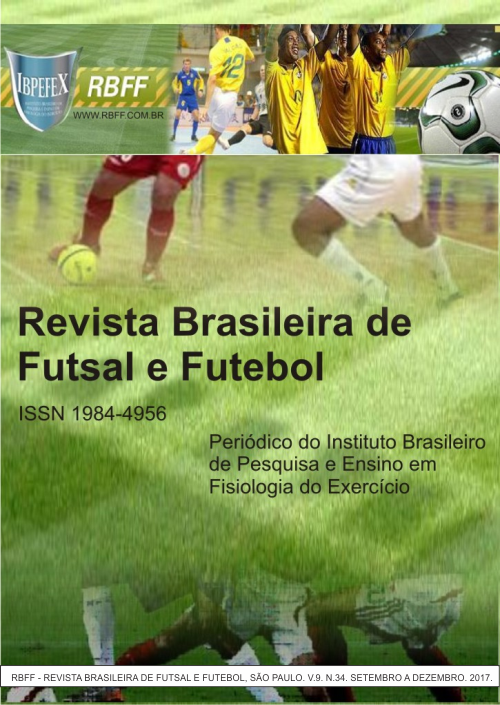Quantitative analysis of the football goalkeeper's actions
Abstract
The scout is a tool that is able to report to the technical comission members about the main technical-tactic events of a football game. By means of the statistical analysis of the results it is possible to get interesting information that enables us to determine which technical demands should be prioritized during the trainings. Purposes: Identifying and quantifying the main actions and/or interventions of the goalkeeper in official games. Comparing these actions by match and checking his significance. Materials and Methods: Data of the 20 state championship games, which corresponded to the participation of up to 15-year-old goalkeepers on a male football team were collected. A scout model was exclusively developed to fill in the information. The collection of data was undertaken in real time during the games. Results: Defenses (16,06%), outside the goal (17,34%), ball replacement (36,19%), line goalkeeper (30,41%). The total number of defenses was significantly lower than the ball replacementes (p=0,0001) and than the play with the feet (p=0,0024) when compared. By comparing the defenses with the other actions in the games considered state classic, only the actions about ball replacement showed a statistically significant difference (p=0,005). Conclusion: It is noticed that the actions of the goalkeeper vary according to the match demandes. the number of defenses was statistically lower throughout the championchip and, in classics, only for ball replacement. According to the opponents' level of difficulty and the teams' homogeneity the conditioning in performing defenses starts to be fundamental. The results of the study let us conclude that the goalkeeper hes to be complete.
References
-Ataíde, E.C.; Bragaglia, F.A.; Costa, I.M.; Manini, J.L.; Marinho, N.F.S. Estratégias utilizadas por goleiros para defender a cobrança de pênalti. Universidade do Futebol. 2015. Disponível em:<http://universidadedofutebol.com.br/estrategias-utilizadas-por-goleiros-para-defender-a-cobranca-de-penalti/>. Acesso em 05/01/2016.
-Berto, E.S.M.; Magalhães, F.C.O.A Estatura como critério de seleção na captação e formação do goleiro de futebol de campo. Revista Brasileira de Futsal e Futebol. Vol. 6. Núm. 20. 2014a. p. 88-94. Disponível em: <http://www.rbff.com.br/index.php/rbff/article/view/240/220>
-Berto, E.S.M.; Magalhães, F.C.O. Composição corporal de goleiros das categorias de base da elite do futebol mineiro. Revista Brasileira de Futsal e Futebol. Vol. 6. Núm. 20. 2014b. p. 95-101. Disponível em: <http://www.rbff.com.br/index.php/rbff/article/view/241/221>
-Borresen, J.; Lambert, M.I. The quantification of training load, the training response and the effect on performance. Sports Medicine. 2009. Vol. 39. Núm. 9. p. 779-795.
-Carlesso, R.A. Manual de Treinamento do Goleiro. Rio de Janeiro. Palestra. 1981.
-Domingues, A. Goleiro 100 Segredos. 20ªedição. Curitiba. Verbo. 1997.
-Drubscky, R. Universo Tático do Futebol-escola brasileira.2ªedição. Belo Horizonte. Ricardo Drubscky de Campos. 2014.
-Federação Mineira de Futebol (FMF). Manual de competições e regulamentos. Disponível em: <http://fmf.com.br/competicoes/proxjogod.aspx?d=4>. Acesso em 03/12/2015.
-Gallo, C.R.; Zamai, C.A.; Vendite, L.; Libardi, C. Análise das ações defensivas e ofensivas, e perfil metabólico da atividade do goleiro de futebol profissional. Revista da Faculdade de Educação Física da Unicamp. Campinas. Vol. 8. Núm. 1. 2010. p. 16-37.
-Gonçalves, A.G.; Nogueira, R.M.O.; O Treinamento específico para goleiros de futebol: uma proposta de macrociclo. Estudos. Goiânia. Vol. 33. Núm. 7/8. 2006. p. 531-543.
-Leitão, R.A.A. Futebol Tático: análises qualitativas como ferramentas de avaliação. Monografia. Universidade Estadual de Campinas. Campinas. 2001.
-Maestri, F.S. Scout no futebol: análise de sequências ofensivas em gols no Campeonato Paulista de Futebol da Série A1 de 2009. Monografia. Universidade Estadual de Campinas. Campinas. 2010.
-Mayer, R. Fichas de futbol -120 juegos de ataque y defensa. Barcelona. Hispano Europea. 1996.
-Mello, R.S. Sistemas e táticas para futebol. Rio de Janeiro. Sprint; 1999.
-Moino, G.S. Análise tática da exigência de situações de jogo para goleiros jovens. Revista Brasileira de Futsal e Futebol. Vol. 3. Núm. 8. 2011. p. 127-141. Disponível em: <http://www.rbff.com.br/index.php/rbff/article/view/106/102>
-Neto, C.P.F. Análise de scout no futebol: fundamentos técnicos individuais da equipe de futebol do Cruzeiro Esporte Clube no primeiro turno do Campeonato Brasileiro 2010. Monografia. Universidade Federal de Minas Gerais. Belo Horizonte. 2010.
-Oliveira, C.E.P. Enciclopédia do América. Belo Horizonte. Carlos Eduardo Paiva de Oliveira. 2012.
-Quintão, R.C. Custódio, I.J.O. Alves, A.L. Claudino, J.G. Quantificação e comparação da carga externa de diferentes conteúdos de treinamento específicos do futebol em relação ao jogo, utilizando um GPS com acelerômetro. Revista Brasileia de Futebol. Vol. 6. Núm. 1. 2013. p. 3-12.
-Ribeiro, H.; Almanaque do Cruzeiro. Belo Horizonte. Henrique Ribeiro. 2007.
-Sneyers, J. Futbol -Manual de entrenamiento. Barcelona. Hispano Europea. 1992.
-Teoldo, I. Guilherme, J. Garganta, J. Para um futebol jogado comideias: concepção, treinamento e avaliação do desempenho tático de jogadores e equipes. Curitiba. Appris. 2015.
-Vendite, C.C.; Vendite, L.L.; Moraes, A.C.; Scout no futebol: uma análise estatística. Campinas. Conexões. 2003.
-Vendite, C.C.; Vendite, L.L.; Moraes, A.C.; Scout no futebol: uma ferramenta para a imprensa esportiva. Congresso Brasileiro de Ciências da Comunicação. Rio de Janeiro. Comunicação e Esporte. 2005. p. 1-10.
-Weineck, J.E.Futebol total: o treinamento físico no futebol. São Paulo. Phorte. 2000.
-Weineck, J.E. Treinamento ideal. 9ªedição. São Paulo. Manole. 2003.
Authors who publish in this journal agree to the following terms:
- Authors retain the copyright and grant the journal the right of first publication, with work simultaneously licensed under the Creative Commons Attribution License BY-NC which allows the sharing of the work with acknowledgment of the authorship of the work and initial publication in this journal.
- Authors are authorized to enter into additional contracts separately for non-exclusive distribution of the version of the work published in this journal (eg, publishing in institutional repository or book chapter), with acknowledgment of authorship and initial publication in this journal.
- Authors are allowed and encouraged to post and distribute their work online (eg, in institutional repositories or on their personal page) at any point before or during the editorial process, as this can bring about productive change as well as increase impact and impact. citation of published work (See The Effect of Free Access).





